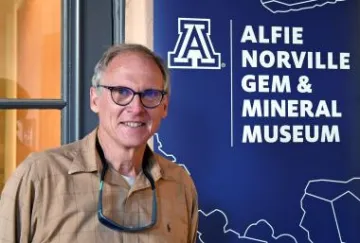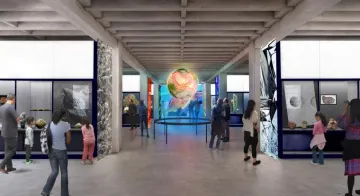December 21, 2020
The 40,000 specimens in UArizona’s mineral collection are about to occupy their new home. Since the former on-campus mineral museum closed at the beginning of 2020, the collection has made its way downtown to a new location. Under the name Alfie Norville Gem and Mineral Museum, the collection will be exhibited in the Historic Pima County Courthouse. The revamped museum, which belongs to Research Innovation and Impact, owes its existence in part to Allan Norville’s lead gift and its name to his late wife. The couple have long been involved in Tucson’s gem and mineral community and founded the annual GJX gem and jewelry show.
The Pima County Courthouse, probably the most iconic building in downtown Tucson, was built nearly 100 years ago. It was completed in 1929 and has been undergoing substantial renovation work during the last few years. Apart from the Gem and Mineral Museum it also houses Southern Arizona Heritage & Visitor Center.
A look behind the scenes

In November 2020, the museum location is still very much in progress. A few, still empty, display cases are already installed, but Eric Fritz, the museum manager, already sees everything in place in his mind’s eye. He has worked on the museum for more than two years, and developed the concept and narrative for the exhibition together with museum designers Ralph Applebaum and Associates in New York. Fritz, who most recently was the Manager North America for Gem-A, the Gemmological Association of Great Britain, shares that the museum designers regarded his idea of rotating up to 20% of the display as overly ambitious. Fritz: “Their experience was: Museum managers like the idea of changing exhibits, but once the museum is finished, they never do.” He is set to prove the opposite.
The plan is to have everything in place by the end of January 2021. When and how the museum opens for the public will depend on the pandemic situation.
Something for everybody
The museum will appeal to and collaborate with the local mineral, gem and jewelry community, but it serves the general public, young and old. Fritz: “We want to convey science, but in a small enough piece for people to stay interested.” The storyline of the museum is told with the aid of projections and monitors as well as touch specimens and some hands-on experiments. One of the first that was already installed compares the magnetic properties of various minerals. But naturally, mineral specimens, meteorites and fossils will take center stage. Most of the specimens come from donations, some were acquired by trades, and some will be on loan.
Three Galleries Showcase Earth sciences
The walkthrough is divided into three galleries, totaling nearly 12,000 square feet. The first gallery, Mineral Evolution displays how man and mineral co-evolved, beginning with the origin of the universe, via worldwide and extraterrestrial mineral specimens. Museum manager Fritz explains: “Our solar system began with around 60 shared minerals among all of the solid celestial bodies. Earth alone has evolved into 5,400 and counting.”
Arizona and Mexico are the focus of the Southwest Mining & Minerals Gallery. It explores the history of mining in Arizona through an amazing diversity of mineral specimens. Turquoise is a famous mineral, less known might be wulfenite. Gem and Mineral Museum Advisory Board member Alexander Schauss, who was instrumental in making wulfenite the Arizonan state mineral confirms: “Mineral collectors around the world know that no place on Earth produces more spectacular specimens of wulfenite than Arizona, including nearly two-dozen mines that for decades produced the finest wulfenite specimens in the world.” No exhibit on Arizona would be complete without the ever-present copper. A wall of the gallery recreates a part of the underground Queen mine in Bisbee with actual minerals.

Artist rendering of the Mineral Evolution Gallery
In the fluorescent gallery the museum takes a twist on the usual display. Fritz: “Usually, the exhibit is presented in daylight and shows ordinary-looking rocks, which transform under ultraviolet light and glow in various colors. We are doing the opposite and use the UV light as standard.”
Fritz remembers one of his early mineral acquisitions in his twenties: A rhodochrosite for $100. “I had to think about it for three days.” Nowadays, he oversees stones with a value many hundred times as much. Specifically in the third and last area, the Gem Hall, which contains a vault for world-class jewelry exhibits. The final gallery introduces gem science, man’s interaction and artistic interpretation of beautiful rocks and minerals. The exhibit on gem cutting and carving includes cutting tools and a real diamond bench from New York. Next to the real gems, synthetic and simulate gemstones are also included.
Upstairs, downstairs
For most of the museum visitors, the visit ends here, but the extensive downstairs area houses a number of rooms and additional facilities. You would expect the archive, offices, and library, but there is also space for public meetings, classrooms, and skill-building workshops. Chris Earnest, Outreach Coordinator for the Lowell Institute for Mineral resources is very much looking forward to bringing groups into the space: “The outreach space in the museum will be a great place for the community to discover the many ways we use minerals in our everyday lives”.
The museum will offer partnerships with the mineral- and gem-related organizations and entities which abound in and around Tucson. The spectrum of uses is rounded off with a research arm for mineralogy and gemology research and thus will be an important facility for the newly-instituted undergraduate gem science program at UArizona. Ananya Mallik, recently appointed The RealReal, Inc. Endowed Chair in Gem Science: “The classrooms and research facilities at the museum will be used to train undergraduate students who are enrolled in the new gem science program on aspects of gem characterization that are of value to the gem world and industry.”
The Museum is now open. Please find all details on its website.

